In 2008 we traveled with the Dutch Travel organization: " Shoestring" in a group to Vietnam. Among our fellow travelers: Pierre (a colleague of Ingrid) and Dita. We get along together very well and agree on traveling together again in the near future.
Now, years later, it's time to put that plan into practice. We make plans for a journey together to Tibet.
We are very curious about Tibet. Tibet: that iconic peaceful, inhospitable country with its deep Buddhist culture and its spectacular scenery. We are told that it is oké to go there right now. Western tourists might contribute in keeping alive the so brutally suppressed Tibetan body of thought.
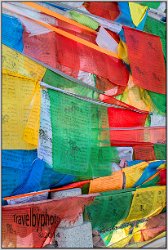
If possible we want to book our trip locally. Via Henk Thoma we receive a contact address in Lhasa. To book a journey in Tibet is not a problem but what a charade to get a visa from the Chinese Government! Never say that you travel to Tibet. If you mention Tibet as the official destination you are assured to get problems. We therefore plan a itinerary to China. After receiving the visa we let - without any problem - rebook the booked trip into a trip to Tibet.
On our journey we will visit many monasteries, meet a lot nice people, wander around in villages and towns, we'll have a view on high mountains tops, explore beautiful plains and see deep blue lakes.
Our flight path runs from Amsterdam via Abu Dhabi to Chengdu in China. From Chengdu we fly to Lhasa (Tibet) and from there we drive overland to Kathmandu (Nepal). We largely follow the so called "Friendship Highway".
The moment we leave Holland we are not yet sure whether it will be possible to cross the border between Tibet and Nepal by car. Early August 2014 The borderarea is hit by major landslides that killed more than 150 people. A whole hillside slipped away. The debris buried large parts of villages and roads. The only road that connects Tibet with Nepal is flooded, and the two countries have been cut off from each other. When we leave this important road is yet been released.
If you click a picture it will be enlarged. The pictures can then be viewed in succession as a slideshow. If you see a link, for example: Shigatse Travels click on the link and it will be opened. When referring to a map, the map can be accessed by clicking on the link : (route)map of Tibet . The clips (images with an arrow) that are included are HD recordings. The clips can be viewed in a separate window that automatically opens when you click on the image with the arrow.
English is not our native language, so we apologize in advance for translation- spelling- and grammar errors.
We take the train from our hometown Schagen to Amsterdam-Schiphol airport. Beyond customs we meet Pierre and Dita our travel buddies.
The plane takes off on time at 22:00. We fly with Etihad Airways. It's a more than 6 hours flight to Abu Dhabi. We have a good comfortable flight.
We are surprised by the view when we fly over Abu Dhabi. a sandbox! Large voids. On the horizon we see skyscrapers and flaring flames of oil refineries. In the sand a pattern is drawn of almost exclusively straight roads and plots distributed in all equal squares. What are they doing there? Who lives there? We see the Formula 1 race circuit. Lots of cranes, skeletons of buildings and construction works.
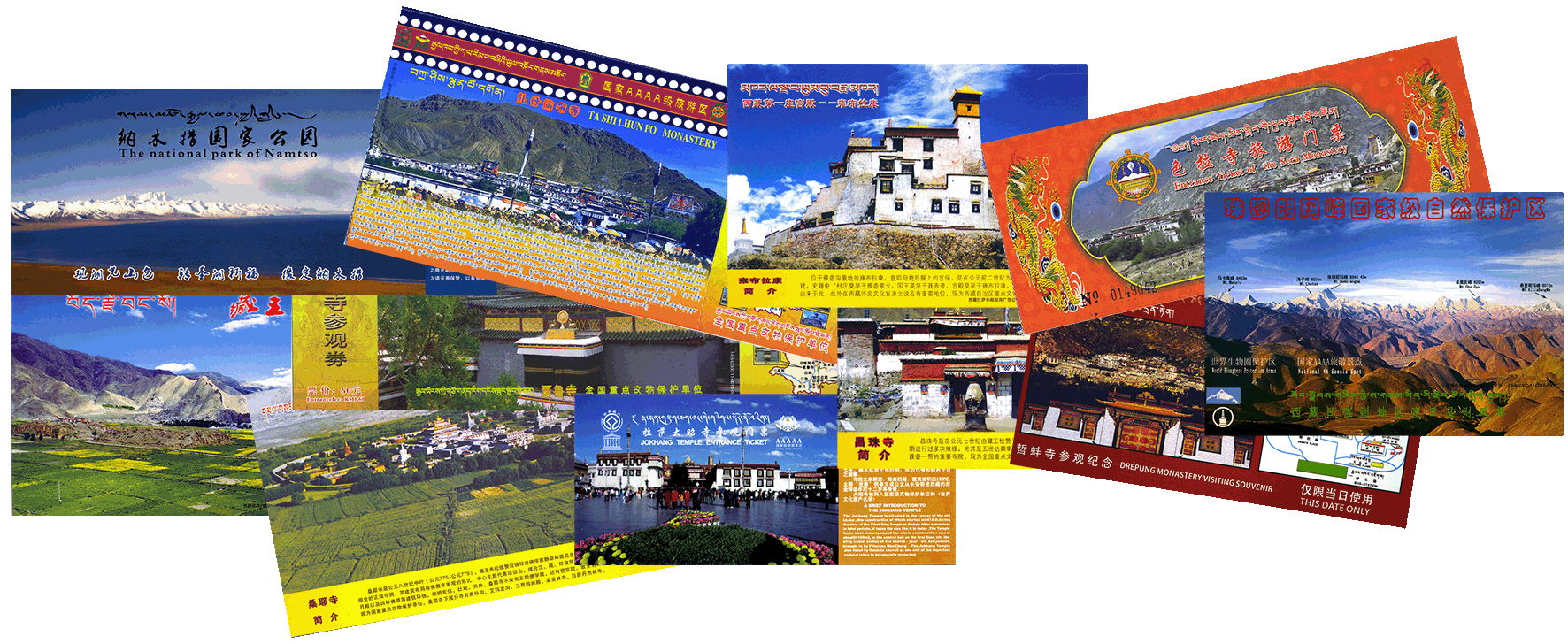
The stopover at the airport takes 2 hours. At 6:35 local am time our onward flight departs to Chengdu; China. The plane is less than half full. It is a quiet flight. We fly over the desert, above sandstorms. We see whole clouds of sand beneath us.
On Chengdu airport we are met by a representative of the travel company and a chauffeur. within no time the customs formalities are completed. We are transported by car to a nice hotel in an old part of the megacity of Chengdu. It is fine to see that the organization runs smoothly at this first stage. That gives us confidence for the rest of the trip.
Chengdu is a city of big contrasts.
There are several Taoist and Buddhist temples, but there is also the West Pearl Tower, which was built in 2006 and measure 336 meters. Many people visit Chengdu because the Chinese panda breeding center is located in Chengdu, but we have no time to visit the city and the pandas. We travel on to Tibet the next day.
Our hotel in Chengdu; the Wejun hotel is surprisingly charming. Built in the style of Ancient Chinese architecture. We get great rooms! Our luggage is delivered to the room. As soon as the luggage is arrived we leave for a walk in the environment of the hotel. It is in the evening, it is dark. The street looks nice, beautiful old buildings. We enjoy street life while we meanwhile search for a restaurant to eat.
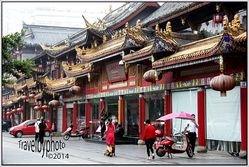
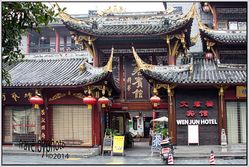
Are you searching for "hot pot" someone asks us. We do not know exactly what that is, but it sounds exciting enough to say yes. The name suggests that it will be a kind of fondue and that appears to be correct. We enter the restaurant and are invited to sit at a table with a circular hole in the middle where a large bowl is placed. There are 2 hot liquids in the bowl, separated by a partition. One liquid/broth is very spicy; the other is mild. We can order anything to cook into the broth and choose; sliced meat and chicken, assorted mushrooms, a kind of asparagus, vegetables and some sauces.
For the first time since our Vietnam trip we eat with chopsticks. That's not easy. We have to get used to it again. The food is very special, but also very tasty. It's cozy eating with that big bowl in the middle. We can even order a bottle of wine in the restaurant! Now, the holiday really has begun! Great!
After our delicious meal in the local restaurant where no other tourists are in sight, and where one almost does not speak any English, we return to the hotel. On our way we buy some mineral water and an extra bottle of wine. We sit the four of us on the cozy patio before our rooms overlooking the courtyard of the hotel and drink health at a safe journey.
Then we go to sleep; It's one o'clock in the morning and it was a long journey.
We sleep well, but not very long. In the morning we take a good hot shower and at 8:00 we are ready for breakfast. Breakfast is served as a buffet. Toast, jam, orange juice, cakes, momo and a fried egg. Also good Chinese tea and coffee included. Everything very effusive. The temperature is 29 degrees Celsius. The heat is quite humid too! It is a bit cloudy. We walk through the street in front of our hotel. Nice walk.
We are picked up at the front of the hotel at 09.30. A ride trough Chengdu in daylight follows. Not only beautiful. At the airport everything goes smoothly. The plane has a half-hour delay. We fly with Sichuan Airlines. We can't look out of the window because our seats are situated at the middle of the plane. It doesn't matter. It's cloudy so there would not be much to see anyway. 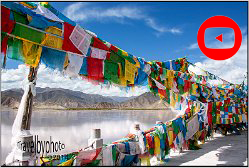 The service on board is fine. Drinks, enough water and tasty rice with chicken.
The service on board is fine. Drinks, enough water and tasty rice with chicken.
And then ... we land at Lhasa Airport. Wow ... we are we in Tibet !! Great! Customs formalities at the airport are easily handled. Outside we are greeted by our driver and our guide Pasang. They welcome us with a Katha (traditional white Tibetan scarf). Our first impression is a good one.
We load the luggage into the car and drive before we knew it into the nature. It will take a journey of approximate 126 km before we arrive at Tsetang (routemap). Our permits are checked for the first time (many more controls will follow).
The roads are fine but the maximum speed in Tibet is 40 km per hour. Fines for speeding are high so the driver always adhered himself to the imposed speed. Moreover, always when he threatens to exceed the speed we hear an undeniable penetrating voice from the navigation system looming into the car as a warning.
It is wonderful to look outside. Still we all close our eyes for a moment and relax. We have traveled from far the last 24 hours. A large part of the route runs along the banks of the river Yarlung Tsanpo (part of the holy Brahmaputra river. The view is stunningly beautiful. Water features with mountains in the background, trees in the water and of course lots of Buddhist prayer flags!
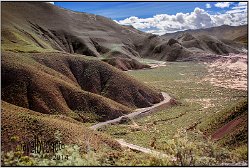
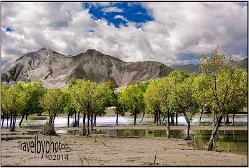
We make a stop at the bank of the river where many prayer flags hang. We drape our garland of flags between the other pendulums "At a good trip and a safe home coming" . Some flags are very big!
After a scenic drive we arrive in Tsetang. First we have to pick up an additional permit at a police station. An "Aliens Permit" (are we really so strange?). Everything is neatly arranged for us by Pasang. He is accustomed to those kind of controls and finishes them quickly and routinely. After fetching the permit we may enter into the city.
We arrive at our hotel. It is a very large hotel; the Shannan Tsedang Hotel. Shannan Tsedang Hotel. Good room but little atmosphere. Comfortable, but clearly a business hotel suitable for large Chinese congresses. In the evening we have dinner in a cozy traditional Tibetan restaurant near the hotel. The restaurant is on the first floor. We would never have found it without Pasang. We sit by low nicely painted Tibetan tables and the food is very tasty. Nothing but local dishes. We drink a bottle Lhasa Beer (Beer from the roof of the world). After dinner we return to the hotel. We go to bed early.
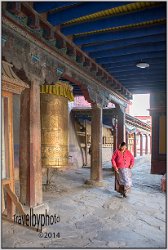
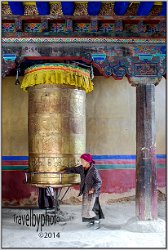
We flew all at once from China to Lhasa.
In one blow you're at 3600 m above sea level. Your body gets no chance to gradually adapt to the height. Therefore, it is actually wiser to visit Tibet overland from China. Tsetang is a few hundred meters lower than Lhasa. Therefore it is a better place for us to acclimatize, but we all have a little trouble with the altitude. Head and breathing don't feel well. Ingrid has slept poorly.
We consume our breakfast in the breakfast room. Almost all the guests in the hotel are Chinese. The breakfast is mediocre. The coffee pot is bubbling on the heat plate. Ingrid starts, after consultation with Dita; she is a general practitioner, taking medicine against altitude sickness (Diamox). She starts with half a tablet a day.
Before we left from Holland, we have examined the weather forecast for Tibet and it didn't look well, but fortunately now we are here the weather turns out to be fine. A bright sun, beautiful clouds and only towards the evening some showers.
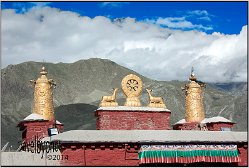
We are in the Yarlung Valley.
First goal of the day: a visit to the Traduk temple (Lamasery). Traduk Lamasery is one of the twelve Tibetan Buddhist Lama temples built by the Tibetan King Songtsen Gampo in the 7th century. Very nice. We take our time to visit the temple and it is fortunately allowed to take some photo's too. Beautiful paintings and beautiful Tibetan people. Our guide tells us all about the different appearances of the Buddha.
After visiting the Traduk temple we drive to Yumbu Lhakhang (route map). An old renovated - actually reconstructed - tower on a hill. The myths surrounding Yumbu Lhakhang make this place special. Yumbu Lhakhang would have given shelter to the Tibetan hero King Nyatri Tsenpo who, in the second century, descended from heaven here. The place also looks a bit like a pilgrims place. The hill next to the tower is covered with a blanket of countless prayer flags.
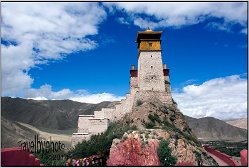
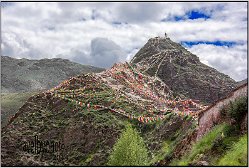
It is a steep climb to the tower on top of the hill. The ladies decide, because of the reduced lung capacity, to go up on a horseback! That's nice, and extremely comfortable. The men do not let themselves know and walk the tough climb to the top.
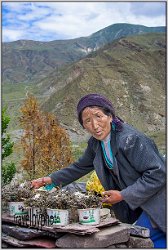
What a nice weather! Only the view on the Yarlung Valley is already worth the climb. At the top we buy a bowl with incense and juniper from an old Tibetan lady. The contents of the container is thrown on the fire in an oven and the incense smoke is dispersed by wave gestures. It's for good luck.
Downstairs, near the parking area is small market where nomadic women with beautifully braided hair buy jewelry.
Our next goal; the Tombs of the Tibetan kings. There are 22 tombs. It is not a large complex, but very special. Meanwhile some very impressive cloud parties above the valley are formed. At the time we are back in the car it starts to rain and thunder. The storm does not last long.
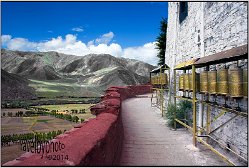
At 15:00 in the afternoon we are back in Tsetang. We have lunch in the restaurant we dine last night. Very tasteful, but also very much!
At 16.00 we are back in our hotel. We meet each other again at 18:00 for a walk into the city. Fortunately, none of us has a headache today. We walk to the restaurant. Along the way we marvel at the shops of dentists who keep practice in the display windows. Diner was delicious. Banana lassi as dessert. Good for our potassium Dita says.
We need to drink a lot here because of the altitude. Side effect, it doesn't take long before we learn to recognize the Chinese character for WC! The state of public toilets is a different story. In the bathroom of our restaurant you'll literally expose yourself in front of a window on the street side .... second floor though. All right .... should be possible. The plumbing in the hotels itself is otherwise fine and hot water everywhere.
Everyone has slept well. After breakfast we leave for the Samye monastery. It's another beautiful ride along the Yarlung Tsangpo river. The landscape is very special here. Imagine yourself a dessert with real sand dunes with snow peaks in the background at an altitude of 3500 m above sea level! Surrealistic. We see yaks, partly in the water, and again those trees in the water. It is not a long journey; only 50 kilometers. Near the monastery is the Samye hotel, where we will sleep tonight.
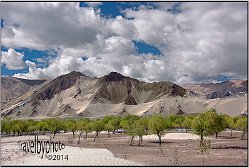
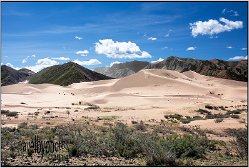
We climbed today from 3100 meters to 3700 meters altitude.
We have lunch in the restaurant of the monastery. There are no other tourists. We are led elegantly inside but the restaurant is dark, stuffy and there are heaps of flies. We therefore quickly go back out and sit at stone benches with tables in a courtyard. There we eat cozy amid the monks and pilgrims. The lunch is vegetarian, very green; spinach and salads.
The toilet here is by far the most filthy toilet is that we have ever seen. Therefore we will not describe him and leave it to everyone's imagination.
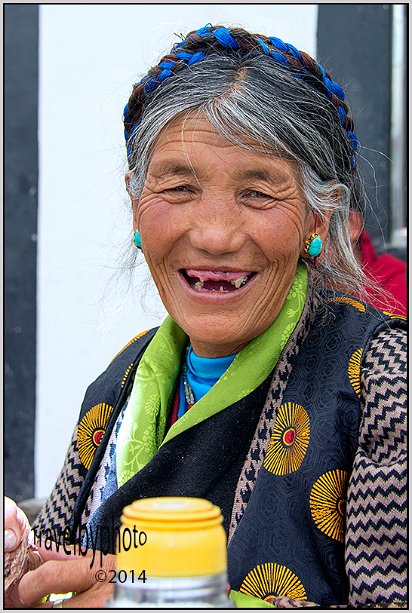
After lunch we visit the Samye Monastery. Samye Monastery is the first Buddhist monastery built in Tibet. Its construction was started around 775 in the period of King Trisong Detsen. The monastery was built as a collection of buildings surrounding a central temple. The monastery thus has the form of a three-dimensional mandala. The central temple itself is supposed to suggest the mythical Mount Meru. A very beautiful monastery and a special experience! It's hard to explain. The atmosphere, the smell, the lights, the altars of the Buddhas and teachers, the murmur of prayers by monks and the sound of the Shaman Drums at a 800 year old temple. Impressive!
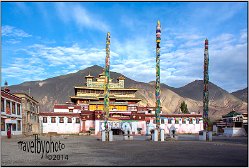
The Chinese occupiers destroyed many buildings, monasteries and religious treasures during the invasion of Tibet and during the cultural revolution . Still, there is a lot left to see. Many believers have risked their lives in hiding images and relics from the invaders. Destroyed buildings are rebuild Truly a very special place here. Pasang explains a lot about the interior of the monastery. After the tour we walk around a bit but it's become very hot, so we decide to recharge in a break.
The restaurant of the monastery this afternoon was really very dirty. They don't collect the used plates with leftovers from the tables. The result? An invasion of flys.
For dinner we are therefore look for another restaurant. We find the Snowland Restaurant Yungdruk. This restaurant is also recommended in the Lonely Planet. It's a nice restaurant with several intimate dining areas with beautiful murals. We eat between ordinary people and have great fun. The food is very tasty.
Today was a delicious dry day but during dinner the storm breaks loose: severe thunderstorms and torrential rains. Luckily we are inside the restaurant on time. For our window we a flock of sheep running in the street.
(route map)
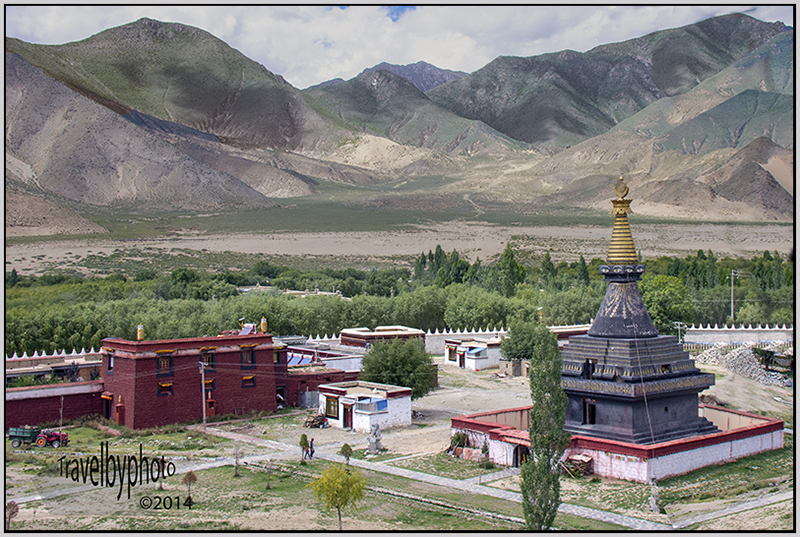
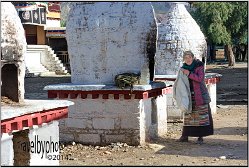 We get up early in order to attend the morning ceremony in the monastery temple.
We get up early in order to attend the morning ceremony in the monastery temple.
The monks have an impressive red cloak with pointy hood draped around them. They sit on low banks. The praying ceremony is led by an old monk on a throne. The cymbals and the Shamans Drums are beaten and the horns are blaring. The monks are offered some butter tea. The whole service will take 3 to 4 hours. We remain for only half an hour. Special entourage here. Filming and photography is not allowed.
After our visit we make a walk on the monastery grounds. We visit several smaller temples, stupas and manimuren.
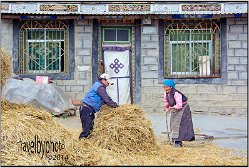
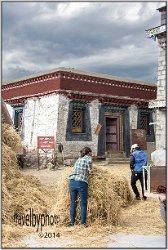
Then we leave for Lhasa; a journey of 206 km (about 6 hours). We drive back mostly the same route as we came. So again the special dune landscape along the banks of the Yarlung Tsanpo river. In Tsetang we have lunch at the local restaurant where we were before.
After lunch we follow our journey to Lhasa. The whole ride is no punishment. Less tired than during the outward journey we enjoy the special landscape. Tibet so beautiful!
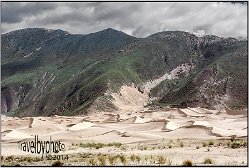
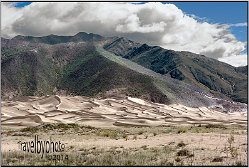
Again a lot of traffic control areas.
It keeps you reminding that you are in occupied territory. The Tibetans themselves are open and friendly to us. We notice that they are careful in what they say, but they are still very critical, and express without doubt that a real Tibetan would never sympathize the Chinese occupation.
Around 16:00 we arrive in Lhasa. The suburbs of Lhasa are modern and very ugly!
The original ‘Old City’ area of Lhasa, which is at least 1,300 years old, today represents less than two per cent of the total area of Lhasa, with the rest of the city constructed mainly out of modern concrete buildings. Hundreds of historic Tibetan buildings have been razed to the ground over the past 20 years, including the village of Shol, once at the foot of the Potala Palace.
In the center of Lhasa you can see what is left of the old city. We arrive at the Yak hotel. Yak Hotel is centrally located near the Barkhor district. Barkhor is the neighborhood of narrow streets and the square in front of the Jokhang Temple in Lhasa. We have a good room with Tibetan murals. We even seem to have a WIFI connection in our room.
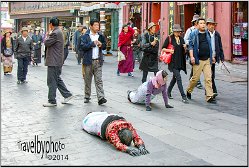
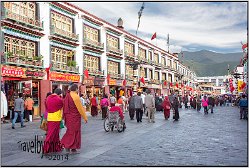
At the end of the day we walk to the old city. Awesome !! Lhasa is chockfull of Kora - walking paths around sacred sites that one circumambulates in a clockwise direction, usually while praying, meditating or prostating. In Barkhor the pilgrims walk in large rounds around the most important temple of Tibetan Buddhism: the Jokhang Temple.
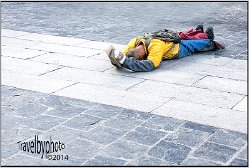
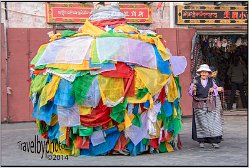
Some Pilgrims repeatedly fall to the ground (prostration, literally pulling down, on-earth-repudiation) while muttering mantras. Prostration is very popular and common in Tibet. It is a movement to worship to the Buddha. It must be lethal tiring. Bystanders offer the postulating Pilgrims money. Buddhists believe one should prostrate at least 10,000 times during his lifetime. Jokhang Temple is the most popular place for prostration. It is always filled with devout pilgrims. Some pilgrims who are far away from Lhasa even prostrate tens of miles along the road to Lhasa. The participants experience a feeling of being 'high', an intense mystical experience. Impressive to see. It is busy. We will certainly be back.
One of the owners of the Yak Hotel is the Dutchman where we booked our trip. Our dinner tonight in the Dunya restaurant is a welcome gift from the tour company. Delicious and well cared for food served outside on the large balcony overlooking the street. Rice, curry, papadum, and very real coffee.
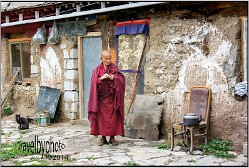
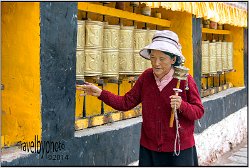
We have breakfast at the hotel. The day starts dark and cloudy, but luckily the weather quickly improves.
Today we take an excursion to the Drepung Monastery. Drepung Monastery is one of the big three-Gelug monastic universities of Tibet. Drepung is the largest monastery in Tibet and was even the largest monastery of all religions in the world. The monastery was founded in 1416 and is located eight kilometers west of Lhasa. It consists of a series of white buildings that are piled up against the Gambo Utse-mountain. The buildings are centered around two magnificent white pagodas. The major buildings are Ganden Potrang, Coqen Hall, the four Zhacangs (or Tantric colleges), and Kamcuns.
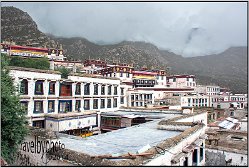
Drepung Monastery was a very rich monastery with 15,000 monks before the invasion of Tibet in 1959,. Today the monastery is much smaller with only a few hundred monks.
It is a beautiful and impressive building complex with numerous different halls and of course lots of images of the Buddha, lamas and other teachers. Many Tibetans who experience their religion walk around. They walk around with thermos flask filled with liquid paraffin, and lumps of butter to refill the bowls with candlewicks. There is a devotional atmosphere.
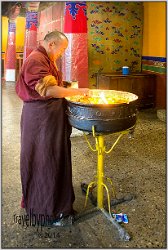
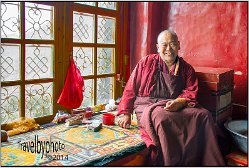
In one of the monastery halls, an altar with a few hundred identical Buddhas is restorated. The Buddhas are picked up one by one, dusted, if necessary repainted and put back again. We too lend a hand. On an old holy throne of a llama sleeps a kitten. There is so much to see!
Annoying however is the fact that you are charged for taking photographs for every single hall you enter, and there are quite a lot different halls in a large monastery as Drepung . 1 to 2 euros a room. Better to charge the fee in once!
In the afternoon we visit the Sera monastery.
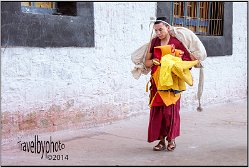

Sera monastery is located at the foot of the Tatipu Hill, three kilometers north of Lhasa. The Sera Monastery is dedicated to the Gelugpa or Yellow Hat Sect. The Sera monastery is our second Gelug monastic university of the day. The monastery was named Sera which means wild rose in the Tibetan language, because the hill behind the monastery was covered with wild roses when the monastery was founded.
The monastery is magnificent. Its main buildings are the Coqen Hall, Zhacang (college) and Kamcun (dormitory). Scriptures written in gold powder, fine statues, scent cloth and unparalleled murals can be found in these halls.
In the courtyard - debate garden - monks held heated debates on Buddhist teachings. The debating traditions in the Sera Monastery are unique. In a battle of words, the monks supplement their discussions by using a variety of gestures including clapping their hands, pushing their partners for an answer, or plucking their prayer beads to win the virtue of the Buddha. We can't understand them of course so it is difficult to estimate how serious the discussions are. The tradition is very old but for us it looks a little bit like a organized show.
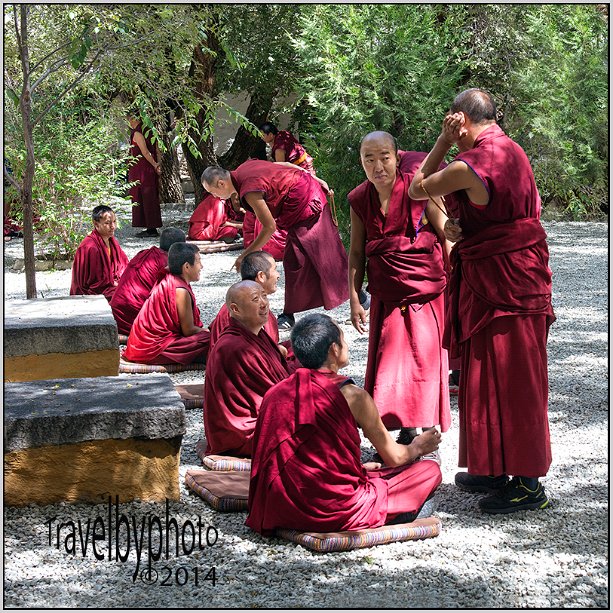
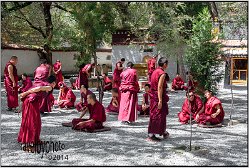
After visiting the Sera monastery we let ourselves drop downtown. We have a drink together, do some people watching and visit some shops. We eat in the "Makye Ame Tibetan Restaurant".
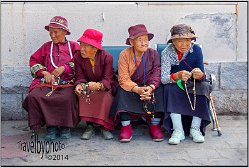
It is a nice restaurant in a typical Tibetan building located in the southeast corner of the Barhor street. We have a table on the second floor at the window. The view over the korlam is unique.
After dinner we walk to the hotel. Just some time to ourselves. We were pretty tired.
Pierre and Dita are visiting the famous Potala Palace today. We also go to the Potala Palace, but we will not enter the palace buildings.
Before the Chinese occupation of Tibet the Potala Palace was the seat of the Dalai Lama and the Tibetan government. Therefore the palace is regarded as one of the main symbols for Buddhism in Tibet.
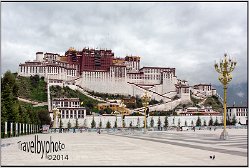
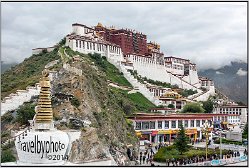
The Potala Palace stands on top of a hill. It is a majestic building. The only reason we skip a visit is because we have heard that everything inside the palace is strictly controlled and regulated by the Chinese. It has become a museum. But you cannot walk around freely. We are not in the mood for a hurried tour, no picture taking and hup hup hup for a lot of money. In the course of our journey, we will have ample opportunity to experience the richness of Tibetan culture in a more quiet and serene way.
Many pilgrims walk a korlam around the palace.
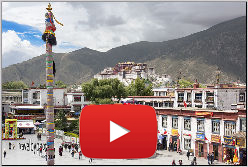
The square at the foot of the hill on which the palace is situated is crowded by Chinese tourists. The square is large and unsociable. A Chinese flag is prominently placed at the roof of the palace and in the centre of the square. Even so: the view on the Palace is unforgettable beautiful.
We take our time and walk without a set plan direction Bankhor. Along the way we wander through narrow alleys, we visit craft workshops and small temples.
We have agreed to meet Pasang at 14:00. He will take us for a visit at Jokhang Temple. Jokhang temple was founded in the year 647 by King Songtsen Gampo (r.617-49), the first ruler of a unified Tibet.
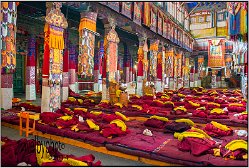
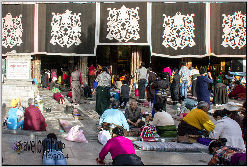
The legend says that Princess Wencheng - the second wife of Song Gampo - reached Lhasa in the year 643. The princess brought a life-size statue of Sakyamuni, also called Siddhartha Gautama or Jowo (the historical founder of Buddhism) with her.
The temple was built to house the sacred image of the Buddha. The image still is in the temple and is the holiest object in Tibet. The temple was expanded regularly over the years, including extensive reconstruction under the fifth Dalai Lama in the 17th century. The core of the temple is really from the 7th century.
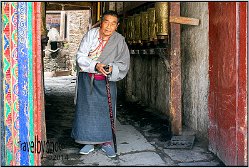
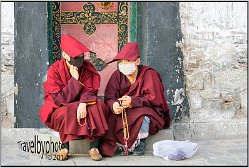
Since the Chinese occupation in 1951, Jokhang temple has acquired a political significance as the focus of Tibetan cultural identity and resistance. A part of the Jokhang was used as a pigsty during the Cultural Revolution (1966-1976). In another part of the temple, Chinese soldiers were housed. The soldiers showed no respect and burned/destroyed many ancient Tibetan writings from the temple.
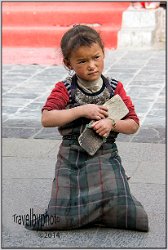
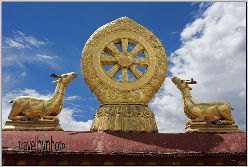
Only when you now see and experience how important the temple is for the Tibetans you can imagine how hurtful the coarse and brutal violation of the sanctuary by Chinese people must be for for the Tibetans. Today, Jokhang temple is open to pilgrims and tourists.
Above the main entrance of the Jokhang temple is a golden wheel with eight spokes, the Dharma Wheel, flanked by two deer. The spokes of the wheel represent the eightfold path (to enlightenment) and the deer serve as a reminder that Buddha gave his first sermon in a deer park. From the roof of the temple you have stunning view of the city. In the distance you ca even see the Potala Palace. In the evening we have diner together. Ingrid is not feeling well and quickly crawls under the sheets after diner
Ingrid stays in at the hotel today. She is not feeling well and has a fever.
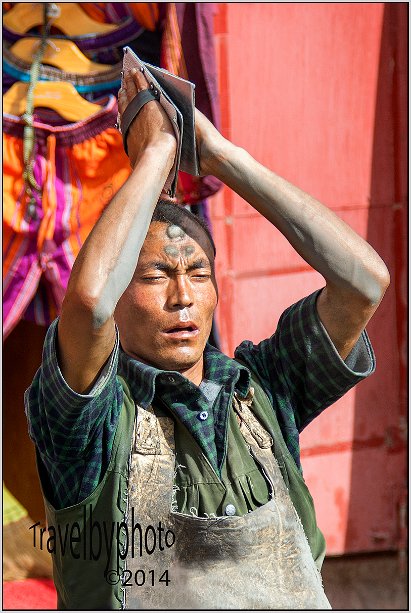
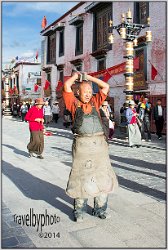
Jan Arend therefore sets off alone. Plenty to see in Lhasa. He chooses a nice bench on the Barhor street to sit on. He sits besite a couple of old Tibetan men and women who are busy talking to each other while continuously turning the prayer wheel, and looks at the colorful parade of people that passes him.
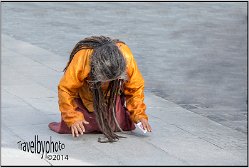
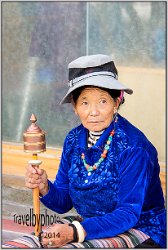 Jan Arend also has a massage in a massage clinic run by blind Tibetan physiotherapists. Relaxing. The physiotherapists are trained in the Institute for the Blind Braille Without Bordes in Lhasa and do their job very competently.
Jan Arend also has a massage in a massage clinic run by blind Tibetan physiotherapists. Relaxing. The physiotherapists are trained in the Institute for the Blind Braille Without Bordes in Lhasa and do their job very competently.
In one of the small craft workshops Jan-Arend buys two beautifully colored patchwork Tibetan temple decorations.